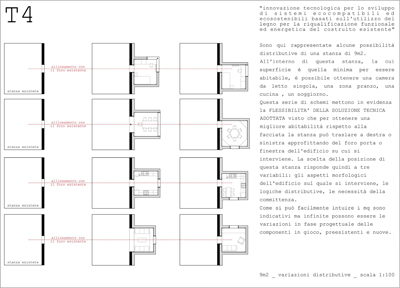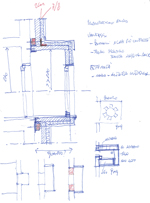You are in: Home page > Magazine Archive > Building retrofitting, a chance to think over the city.

Paola Virgioli
Building retrofitting, a chance to think over the city.
Attaching, Including, Raising, Cladding
Abstract
Within a multidisciplinary group of scientists, who worked upon a research named “INNOVATIVE TECHNOLOGY FOR ECO-STAINABLE AND ECO-FRIENDLY TIMBER SYSTEMS FOR ENERGY AND FUNCTIONAL UPGRADING OF BUILDINGS”, our role as architects interested in urban design, has been among the others, that one of focusing upon the human being and a particular environment in which he would choose to live in: the Italian historical city.
Article Text
Within a multidisciplinary group of scientists, who worked upon a research named “INNOVATIVE TECHNOLOGY FOR ECO-STAINABLE AND ECO-FRIENDLY TIMBER SYSTEMS FOR ENERGY AND FUNCTIONAL UPGRADING OF BUILDINGS”, our role as architects interested in urban design, has been among the others, that one of focusing upon the human being and a particular environment in which he would choose to live in: the Italian historical city.
Our research, close to celebrate one year of work, has focused on the need of renewing the existing buildings stock, in the case it is not conforming the new planning and anti-seismic regulations. We have realized that the structural/seismic side of projecting buildings has been not dealt with in the past, so that we have no previous experience to be inspired by. A way to increase the building quake-proof performances is to clad it with Xlam panels, that will work together with the existing masonry blocks. Similar cases we have studied have never gone deeper than the analysis of the reinforcement layer's response. Our group, instead, has decided to take into consideration the complete set of cladding components. This is why, in our research, we have tried to imagine the final result of the project process as if it should be immediately applied to an existing building.
Since we had to move form very important technical aspects, as anti-seismic solutions are, we felt interesting to take the chance of meditating on which role architecture has to play when coping with them, considering the building design and the impact our solution may have in a urban scale. Being working without a specific context, nor a specific place, and being in the need of showing how our technical solutions could fit any conditions, we created ideas/results in possession of the power of a slogan.
In order to define our research lines, we have made some considerations.
The use of timber can reveal very interesting results when imagining it in a specified context. Key words of our research title are eco-sustainable and environmentally friendly, together with energy and functional improvement. If we add to them the idea of reversibility you can see how specific can be the result. Our goal is to show how the use of wood will constitute an added value when intervening in a situation of sensitive and valuable environment. This is the reason why we have stressed upon this peculiar aspect of timber employment, while developing our study. Building inside an historical city means that you have to confront yourself with its heritage and work under very restrictive regulations that could also be modified thanks to the choice of suitable technical solutions.
Four words can define our approach to the building and its urban contexts: ATTACHING, INCLUDING, RAISING, CLADDING. These words not only indicate the physical ways to work with a building but even the potential of design actions. We fell upon them while observing and studying both recently issued works of architects, we found in specialized web sites and magazines, and traditional existing architectures.
RAISING and CLADDING refer to typical mountains areas interventions. Being our research financed by the Regione Veneto – Funds FSE 2007/2013 – our thoughts went immediately to all typical Dolomites buildings, where above a stone basement timber is used to create living spaces. We had also in mind the astonishing Edoardo Gellner's architectures, in which we found evidence of his study of the complex timber-work tradition that has been brought to a more contemporary construction concept. Another issue to take into account is the recent evolution of all renewing and building techniques carried out with timber. Glued laminated timber and XLAM panels match together high strength performances, fast execution and, last but not least, the very specific quality of timber: its lightness
With ATTACHING we entered into the substance of the project and described different ways of approaching the external side of a building. First step: XLAM panels cladding the exteriors of the building, this new wooden wall is anchored to the masonry blocks, helping the building to survive to the strongest earthquakes. Cladding with Xlam panels improves the building thermal insulation, technical performances and generates the opportunity to expand its surface area with small size rooms. This specific approach is suitable for Italian buildings from the 50s/60s which structural frame is composed with concrete onto which anchor the Xlam panel. Furthermore this addition of external small wooden room and their easy revertible nature is especially appropriate in inner backyards of the historical city.
As far as INCLUDING is concerned, we have worked our solutions in a “landscape restrictions” situation, since we have chosen for our project an hypothetical old historical Palazzetto. In this specific case, the consolidation takes place from the inside, emptying it completely retaining only the facade. It is an already experienced operating method in European historical city centres, but as we projected it, it carries along many benefits for the building itself: better resilience to earthquake, better thermal insulation, possibility of improvement of its technological equipment. Therefore a chance to become a smart building. It has been important for us architect to go beyond the building technological equipment and think about what are the consequences that these radical operations can create in the urban context. We found two different directions; the former leading to a new living and working concept that can suit the expectations of the "new creative user" that are now repopulating the city centres. The latter, instead, focused more upon the “ground floor”, re-thinking it as a semi-public area strictly bonded to the sidewalk and the street.
In order to “recognize the unquestionable role of the ground floors, the location of the dissolution of the boundary between public and private”[1], considering it inside a contemporary city, we have to give a very important place in the development of our project to all existing non-varying elements (such as ways in and out, up or down, stairs, elevators, shops, gardens, waiting rooms, receptions, ticket-offices, coffee places, etc...). Moreover, an emptying action sometimes gives also the chance to the designer to insert a new floor being ceilings height often wider than in recent constructions.
Beyond the mere speculation aspect, that is usually the reason behind these actions, we think that is also a chance to meditate on the paths that such operations generate in the historical city centres, contemplating even the change of designation of dwelling houses.
The level of abstraction that this type of research requires, pushed our considerations into the singles elements of Architecture. We are considering and designing these elements in order to create a catalogue, with which compose bow-windows, small attached rooms, cozy entrances, etc. Our goal is to obtain a wide range of designed construction details which can give a starring role also to joints and anchoring parts. These elements and the way they connect to each other are the constituent materials of all buildings, but definitely also gaps, corners, side walks, doors, show windows and gates are the constituent materials of the whole city. With their overall quality they add value to the Architecture.
The return of politics as an active subject, as wished by many reviewers of the smart city idea, may happen, in our opinion, not only by promoting new projects of public areas with technological improvements, but also keeping in mind the idea of a city made by material elements and also by a never-ending dialogue between public and private spaces.
The human being is the pivot of some designed smart cities, only in the case to the society has been given the opportunity to generate good relationships that allow the improvement of the urban spaces. Every consolidation action should become the right moment to create complexity, melting pots of diversities, produce variety.
We frequently face the need of improving the earthquake resilience of historical heritage, so why not taking the chance of projecting and designing following the best sustainability criteria, using environmentally friendly materials and new techniques.
These interventions are usually possible only thanks to massive money investments, therefore an important role of the architectural project could be the one of contemplating the mixity of the contemporary city as well as of the historical city.
[1] Manuel De Solà-Morales, For a ‘material’ urbanity, in “A Metter of Things”, NAi Publishers, Rotterdam, 2008, pag. 147
Bibliography
Manuel De Solà-Morales, For a ‘material’ urbanity, in Manuel De Solà-Morales, “A Metter of Things”, NAi Publishers, Rotterdam, 2008, pag. 146-153;
Rem Koolhaas, My thoughts on the smart city, Brussels, 2014 in http://ec.europa.eu/archives/commission_2010-2014/kroes/en/content/my-thoughts-smart-city-rem-koolhaas.html;
Rem Koolhaas, Balcony, Marsilio, Venezia, 2014;
Rem Koolhaas, Facade, Marsilio, Venezia, 2014;
Rem Koolhaas, Window, Marsilio, Venezia, 2014;
Franco Purini, Una lezione sul disegno, edited by, Franco Cervellini, Renato Partenope, Gangemi, Roma, 1996;
Jeff Rison, Urbanistics for the people, in “The smart city La città dell’uomo” supplement a Domus n. 985, Novembre 2014, p. 10-13;
Paolo Testa, The human dimension of the smart city, in “The smart city La città dell’uomo” supplement of Domus n. 985, Novembre 2014, p. 14-15;
Edoardo Gellner, Architettura rurale delle Dolomiti venete, Edizioni Dolomiti, Cortina, 1988;
Rafael Moneo, Su luogo, tempo e specificità in architettura, in “L’altra modernità. Considerazioni sul futuro dell’architettura”, Cristian Marinotti Edizioni, Milano, 2012, pag. 39-51.
Paola Virgioli: now attending a PHD at IUAV, curriculum Architectural Composition. She has been collaborating with the teaching team of s.s.d. ICAR 14., since a few years She has been member of both national and international researches teams. She won scholarships in Erasmus and Leonardo programs. Her working experience has seen collaborations with Italian and foreigner architects, as well as self signed works.















